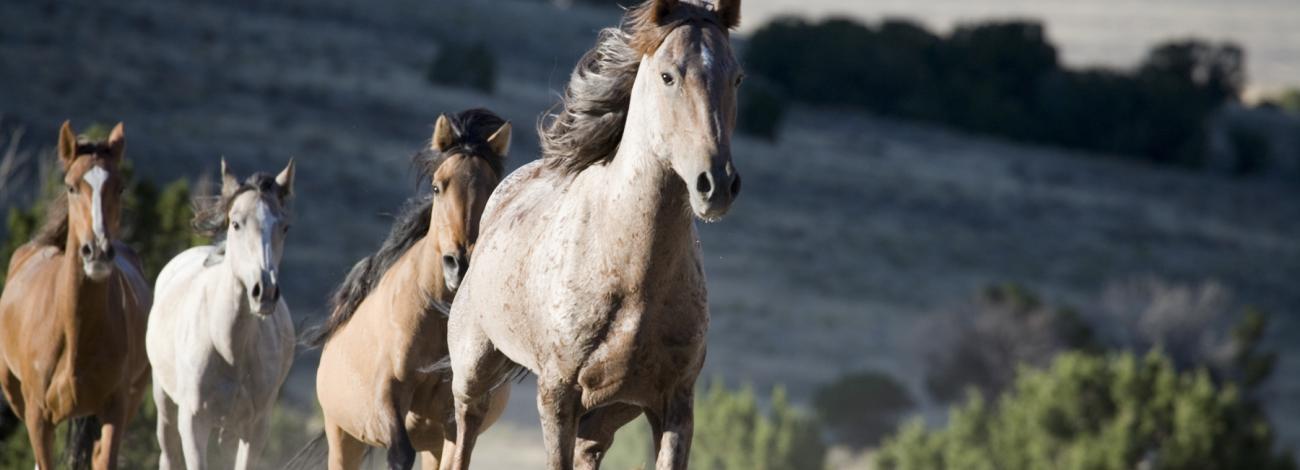
Conger HMA
The original source of this herd is unknown. However, many of the horses in the Conger Herd are descendants of horses that were turned loose or escaped from local ranches. This herd is being managed to maintain the black, roan, palomino, pinto and dun colors. The wild horses on the Congers average 13 to 14 hands tall and 700 to 1000 pounds.
Location
The Conger Mountains Herd Management Area (HMA) is located 75 miles west of Delta. The HMA is bounded by old Highway 50 & 6 on the south, and Cowboy pass on the north. Horses can be viewed from any of the main roads and springs within the HMA.
Size
The HMA contains 151,506 acres of BLM lands and 19,487 acres of Federal, State, and privately-owned land for a total of 170,993 acres.
Topography/Vegetation
Temperatures range from 100oF in the summer, to sub-zero in the winter. The wild horses primarily use the lower benches and valley bottoms in the winter and the higher elevations in the summer. The HMA has some forested areas comprised of pinyon/juniper trees primarily along ridge tops and across Conger Mountain. The soils within the area are primarily loams. Terrain features may require horses to travel several miles between water and forage along well-defined trails.
The HMA ranges from 5,200 feet in the valleys to 8,070 feet in elevation at the top of Conger Mountain. The HMA supports vegetation types of black sagebrush and pinyon/juniper. Open areas outside of the pinyon/juniper sites are dominated by blacksage/grasslands. There are a few juniper trees that occur on the valley floors and low hills among the blacksage/grasslands. Key species include indian ricegrass, bottlebrush squirreltail, galletta, needle-and-thread grass, sand dropseed and winterfat.
The HMA has four major springs that have been developed providing water storage across the HMA. These springs (Conger, Skunk, Willow, and Knoll Springs) provide permanent water to sustain wild horses and wildlife through the summer. Skunk and Willow Springs are in the north portion of the HMA. Conger Spring is in the central and Knoll Spring is on the west side of the HMA. Skunk and Conger Springs have been developed with pipelines and a series of storage tanks and troughs to provide the water sources for the wild horses, wildlife and livestock during authorized grazing seasons. The northern portion of the HMA has been designated as crucial habitat for wild horses. Skunk, Willow and the upper Conger Springs are located within this designation and all available surface water is available for wild horses and wildlife.
Wildlife: Mule deer habitats in the Conger HMA has been identified as crucial winter range. During spring, summer and early fall, deer fed primarily on a variety of forbs and grasses, with light use on big sagebrush, black sagebrush and antelope bitterbrush. In fall and winter, deer shift their diets to shrubs including big sagebrush, black sagebrush, antelope bitterbrush, Gambel oak and curlleaf mountain mahogany.
Pronghorn typically utilize a variety of vegetation with shrubs being highest in composition followed by forbs and grasses and is used yearlong. Predator species are not common in the HMA.
Appropriate Management Level (AML)
40-80
Viewing Opportunities
Travel west from Delta on U.S. Highway 50 & 6 approximately 75 miles to the Little Valley Road (mile post 16). Turn north on the Little Valley Road and travel approximately 8 miles to the Skunk Springs (Camp Canyon) Road. Horses can usually be found in the vicinity of Conger Springs, Camp Canyon, and Skunk Springs. Another area horses can be viewed is in the vicinity of Knoll Springs. To reach this area, turn north from U.S. 50 & 6 at the Eskdale turnoff near mile post 8. Travel approximately 15 miles to the intersection of Knoll Springs and old Highway 50 & 6. Horses can be viewed on the slopes east of Knoll Springs and on the benches south of Cowboy Pass.
Special Travel Conditions
Access is provided to the HMA by several dirt roads that originate from Utah State Highways 6 and 50. However, the condition of the roads can very on a daily basis due to weather conditions.
